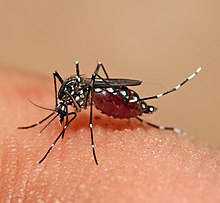Aedes
| Aedes | |
|---|---|

| |
| Aedes aegypti | |
| Scientific classification | |
| Domain: | Eukaryota |
| Kingdom: | Animalia |
| Phylum: | Arthropoda |
| Class: | Insecta |
| Order: | Diptera |
| Family: | Culicidae |
| Tribe: | Aedini |
| Genus: | Aedes Meigen, 1818 |
| Type species | |
| Aedes cinereus Meigen, 1818
| |
| Species | |
Aedes (also known as the tiger mosquito
First described and named by
Systematics and phylogeny

The genus was named by Johann Wilhelm Meigen in 1818. The generic name comes from the Ancient Greek ἀηδής, aēdēs, meaning 'unpleasant'[5] or 'odious'.
As historically defined, the genus contains over 700
Characteristics
Aedes mosquitoes are visually distinctive because they have noticeable black and white markings on their bodies and legs. Unlike most other mosquitoes, they are active and bite only during the daytime. The peak biting periods are early in the morning and in the evening before dusk.[8][9]
Direct children of this genus
The genus contains 28 species that are not placed in a further subgenus:[10]
- Aedes daliensis (Taylor, 1916)
- Aedes mallochi Taylor, 1944
Children with uncertain position
- Aedes alticola Bonne Wepster, 1948
- Aedes auronitens Edwards, 1922
- Aedes australiensis (Theobald, 1910)
- Aedes biocellatus (Taylor, 1914)
- Aedes britteni Marks and Hodgkin, 1958
- Aedes candidoscutellum Marks, 1947
- Aedes crossi Lien, 1967
- Aedes eatoni (Edwards, 1916)
- Aedes gracilelineatus Bonne-Wepster, 1937
- Aedes keefei King and Hoogstraal, 1946
- Aedes peipingensis Feng, 1938
- Aedes koreicoides Sasa, Kano and Hayashi, 1950
- Aedes lauriei King and Hoogstraal, 1946
- Aedes monocellatus Marks, 1948
- Aedes oreophilus (Edwards, 1916)
- Aedes plagosus Marks, 1959
- Aedes quasirubithorax (Theobald, 1910)
- Aedes roai Belkin, 1962
- Aedes rubiginosus Belkin, 1962
- Aedes sintoni (Barraud, 1924)
- Aedes stanleyi Peters, 1963
- Aedes subauridorsum Marks, 1948
- Aedes toxopeusi Bonne-Wepster, 1948
- Aedes tsiliensis King and Hoogstraal, 1946
- Aedes versicolor (Barraud, 1924)
- Aedes wasselli Marks, 1947
- Aedes annuliventris Blanchard, 1852
As disease vectors
Members of the genus Aedes are known vectors for numerous viral infections, including
Aedes can be detected and monitored by ovitraps.
Sequencing
The genome of the yellow fever mosquito (
References
- LCCN 2019041641.
- PMID 3576225.
- ^ "Aedes". Walter Reed Biosystematics Unit. Archived from the original on 2016-04-06. Retrieved 2016-02-04..
- PMID 24025625.
- PMID 24473798.
- .
- .
- ^ "Dengue and severe dengue". World Health Organization. 24 October 2019.
- ^ "Dengue and severe dengue". World Health Organization. 19 May 2021.
- ^ "ITIS - Report: Aedes". www.itis.gov. Retrieved 2022-10-07.
- ^ "CDC Transmission of Zika virus". Archived from the original on 2017-09-20. Retrieved 2017-09-08.
- ^ "PAHO Statement on Zika Virus Transmission and Prevention". Pan American Health Organization. 2 February 2016. Archived from the original on 2016-01-26. Retrieved 2016-01-26.
- ^ Fitzsimons, Tom (11 March 2022). "EPA OKs plan to release 2.4 million more genetically modified mosquitoes". NBC News. Retrieved 2022-03-13.
- PMID 17510324.
- ^ "Aedes aegypti". VectorBase. Archived from the original on 1 August 2019. Retrieved 3 November 2013.
- PMID 30429615.
External links
- Singapore Government dengue site that describes the mosquito
- "Aedes". NCBI Taxonomy Browser. 7158.
